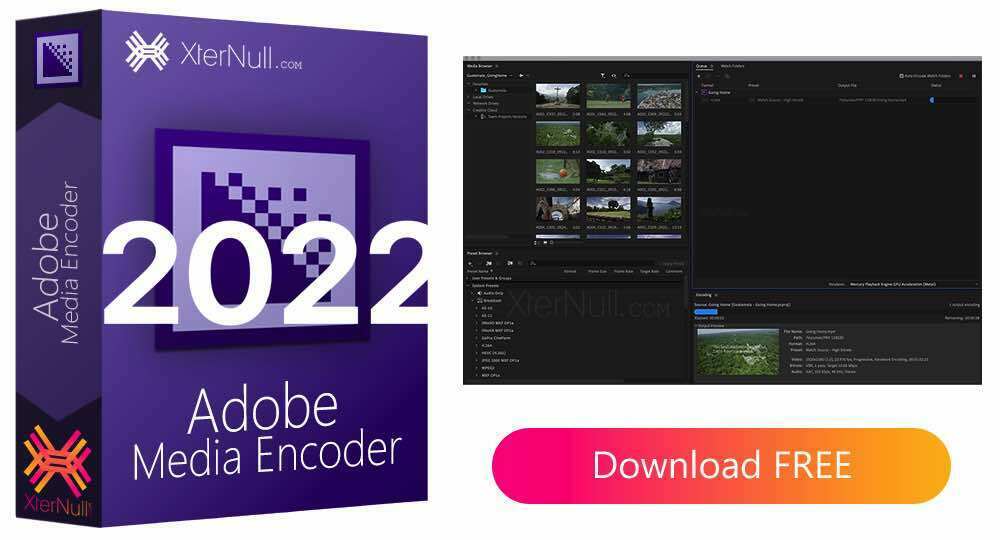

- Best media encoder software how to#
- Best media encoder software for mac#
- Best media encoder software 720p#
- Best media encoder software full#
- Best media encoder software pro#
Multicore processor with 64-bit support required.System Requirements and Technical Details Support for HDR in HEVC (H.265) export Export support for Panasonic AVC-Long GOP Op1b.Export support for ambisonic audio (H.264 only).Streamlined bit depth and alpha channel settings (QuickTime only).
Option to maintain playback in Premiere Pro while rendering in Media Encoder. Support for Color Profiles from After Effects sources. Timecode modification for 720p 59.94 media. Warning when importing non-native QuickTime sources. Notification for missing items in queue before encoding. Add custom titles when publishing to YouTube, Facebook, or Vimeo. Playlist selection when publishing to YouTube. Destination Publishing support for new Twitter 280-character limit. Support for importing Sony Venice camera formats.  Improved Sony RAW/X-OCN camera format decoding. Export XAVC QFHD Long GOP 4:2:2 formats. Use strict CBR encoding recommended for optimum adaptive bitrate performance.With Premiere Pro, Audition, and other Adobe Creative Cloud family media packages, you get free Adobe Media Encoder for media processing, conversion and export. Make sure there is a unique stream name for each video quality. Ensure that there is key frame or GOP temporal alignment across video qualities. Stick to supported resolutions and frame rates for the type of Live Event you are broadcasting to (for example, 60fps is currently rejected.). Use the H.264 video and AAC-LC audio codec output.
Improved Sony RAW/X-OCN camera format decoding. Export XAVC QFHD Long GOP 4:2:2 formats. Use strict CBR encoding recommended for optimum adaptive bitrate performance.With Premiere Pro, Audition, and other Adobe Creative Cloud family media packages, you get free Adobe Media Encoder for media processing, conversion and export. Make sure there is a unique stream name for each video quality. Ensure that there is key frame or GOP temporal alignment across video qualities. Stick to supported resolutions and frame rates for the type of Live Event you are broadcasting to (for example, 60fps is currently rejected.). Use the H.264 video and AAC-LC audio codec output. It comes as an alternative to Wondershare UniConverter and offers almost all the core services and features to make it one of the best file converter for Mac devices. For high-scale events, we recommend starting the setup an hour before your event. ffWorks is a comprehensive command-line software used to convert media files between formats.
Ensure that you give yourself ample time to set up your event. Microsoft does not re-validate encoders on this list, and most validations are done by the software vendors directly as a "self-certification." Always test and validate newer versions of encoder software for continued compatibility with Azure Media Services. If you stop and start the live event without resetting it, the live event will preserve the previous configuration. If you change your encoder configuration, you need to reset Live Events and restart the live event in order for the change to take place. Configuration changes can cause the event to become unstable. Changing your encoder configuration after it has started pushing has negative effects on the event. When using software-based encoders, close out any unnecessary programs. 
Although not mandatory, this simple rule helps to mitigate the impact of network congestion.
When you're determining bandwidth requirements, double the streaming bitrates. Whenever possible, use a hardwired internet connection. Playback of the video-only stream is not supported. To play back content, both an audio and video stream must be present. Configuring on-premises live encoder settingsįor information about what settings are valid for your live event type, see Live Event types comparison. Encoders are not tested or validated by Microsoft on a continual basis and support or bugs can be introduced by the encoder vendors or open source projects that break compatibility at any time. The above list of encoders is just a recommendation list. When streaming via RTMPS, check firewall and/or proxy settings to confirm that outbound TCP ports 29 are open. When streaming via RTMP, check firewall and/or proxy settings to confirm that outbound TCP ports 19 are open. The supported URL schemes are rtmp:// or rtmps://. Media Services recommends using one of following live encoders that have RTMP as output. Encoder requirementsĮncoders must support TLS 1.2 when using HTTPS or RTMPS protocols. For instructions on how to verify your on-premises live encoder, see verify your on-premises encoderįor detailed information about live encoding with Media Services, see Live streaming with Media Services v3.
Microsoft Azure Media Services does not do full or rigorous testing of each encoder, and does not continually re-verify on updates. The verification is done through vendor self-verification or customer verification. This article discusses verified on-premises live streaming encoders. The Live Event then performs live encoding of the incoming single-bitrate stream to a multi-bitrate (adaptive) video stream. The basic pass-through is the most economical, but is limited in capabilities.Īn on-premises live encoder sends a single-bitrate stream to the Live Event that is enabled to perform live encoding with Media Services in one of the following formats: RTMP or Smooth Streaming (fragmented MP4). The service supports a basic and standard pass-through mode depending on your ingest requirements. Using a pass-through method is the most economical way to do live streaming.







 0 kommentar(er)
0 kommentar(er)
